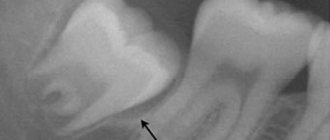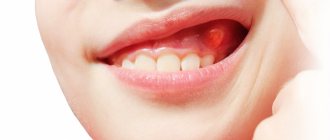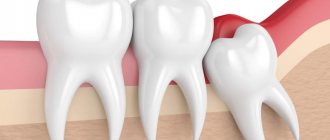Features of wisdom tooth eruption
Wisdom teeth or third molars, also known as figure eights, are the outermost teeth in a row, located at the edges of each jaw. There are four of them in total, but often not all of them erupt, and sometimes they may not grow at all.
This will not affect the chewing functions of the jaw, and if you do not have a single eight, there is no need to sound the alarm.
The eruption of third molars is possible at any age, even after 30 years; the patient’s age does not affect the course of the process. But the direction of growth, the presence of free space in a row, the structural features of the jaw can significantly influence the process - will it be painful or will it go unnoticed, will there be a health hazard and will the growth provoke the development of inflammation.
Wisdom tooth is cutting and gums are swollen
Pain and slight swelling can be physiological and caused by the impact of sharp bumps on the soft gum tissue. They can also be a symptom of a pathological process that develops due to lack of space for the normal eruption of the eighth tooth. As a result, the G8's growth is going in the wrong direction. A hood is formed over the crown, under which microparticles of food that cannot be removed by traditional hygiene methods fall, and an inflammatory process develops.
What to do if your wisdom tooth is cutting out and your gums are swollen? If your gums or cheeks are swollen, you need to go to the clinic.
Intense pain and tumor growth on the gums can signal various pathological processes:
- pericoronitis;
- purulent inflammation, abscess, phlegmon;
- periodontitis;
- granuloma, cyst.
If you have a problem similar to that described in this article, be sure to contact our specialists. Don't diagnose yourself!
Why you should call us now:
- We will answer all your questions in 3 minutes
- Free consultation
- The average work experience of doctors is 12 years
- Convenient location of clinics
Single contact phone number: +7
Make an appointment
There are often situations when a wisdom tooth is cut and the cheek is swollen. This usually happens if the inflammatory process begins to spread to soft tissue. A swollen cheek is a sign of the progress of purulent inflammation, and it is dangerous to further delay contacting a periodontist. In most such cases, the “eight” will have to be removed.
Pathologies that require dental care
Eights can take several days, months, or even years to erupt. Growth is accompanied by a slight aching pain, swelling, and redness of the gums - this is the norm.
But there are a number of symptoms that indicate the development of complications and when you should consult a dentist:
- severe acute pain in the gum area;
- pain that spreads to the ear, throat, temples, head;
- increased body temperature;
- inflammation of gum tissue, purulent discharge;
- the appearance of bad breath;
- discomfort, pain when chewing;
- pain when opening the mouth;
- enlarged lymph nodes.
These are signs of inflammation that can lead to infection, loss of adjacent teeth, and sepsis.
Possible pathologies during the eruption of wisdom teeth:
- Incorrect position of the tooth, as a result, it grows sideways into the cheek, injuring, causing pain and inflammation of the soft tissues. At the same time, it causes displacement of the remaining dental units and malocclusion. In the worst case, a malignant tumor may form. It is impossible to correct the direction of growth; the incorrectly growing molar must be removed.
- If it grows towards an adjacent unit, it will damage or completely destroy its crown. The pathology is accompanied by constant severe pain, the inability to chew food normally, and talk. The solution to the problem is surgical removal.
- Pericoronitis is inflammation of the gums. Since the third molars are located in an area that is difficult to clean, leftover food, drinks, and microbes get into the gum tissue. Bacteria cause infection, inflammation, dangerous intoxication of the body, blood poisoning. Symptoms of pericoronitis include severe swelling of the gums, facial asymmetry, acute persistent pain, purulent discharge, and high fever. You should contact the clinic immediately.
Symptoms of wisdom tooth inflammation
To prevent a problem, you need to immediately notice the symptoms that cause it. To do this, special attention should be paid to the following points:
- there is a prolonged tugging pain;
- the gums become hard;
- the adjacent tooth becomes loose;
- body temperature rises;
- lymph nodes enlarge.
To alleviate his condition, the patient can take an analgin or paracetamol tablet at home before visiting a doctor, rinse his mouth with an antiseptic, and use only liquid food for nutrition.
If the pain is severe, you can take a painkiller pill, but you cannot suppress the pain with pills for a long time. You still need to go to the dentist.
How to eliminate pain and discomfort
In the absence of pathologies, it is possible to eliminate pain by taking painkillers Nurofen and Ibuprofen. Ideally, consult your dentist before using anesthetics.
It is impossible to accelerate growth or influence the process, but you can facilitate it by cutting the gum. The decision about surgery is made by the dentist based on the clinical picture.
Minor inflammations can be easily removed by rinsing the mouth with antiseptic compounds and herbal decoctions. Otherwise, all you have to do is wait for the tooth to erupt. A consultation with a specialist will allow you to identify deviations in time and prevent risks.
What to do if a wisdom tooth grows?
Many people have many different stories and memories associated with the process of teething: indeed, the sensations are not the most pleasant, as are the possible consequences. We wrote about the procedure for removing wisdom teeth in Kirov in a separate article, however, this time we propose to consider the process of eruption and growth of the so-called “eights” - there is also something to discuss and what to pay serious attention to. In this material we will talk about the duration of the process, symptoms, features and ways to accelerate growth.
Wisdom teeth: temporary indicators
When covering this issue, attention should be paid to two parameters: this is the age at which wisdom teeth can erupt, as well as the duration of growth during which a person may experience discomfort:
- Age. It is noteworthy that “eights” appear in different people at different times. In addition, their eruption may not take place at all, not to mention the total number of such teeth - some grow only one wisdom tooth, some have two or three, and some can boast of having all four. As a rule, “eights” begin to grow between the ages of 16 and 25, however, there are cases of teething even after forty. Any deviation from this norm is not at all a sign of any disease, therefore, there is no cause for concern;
- Duration of eruption. It is impossible to give an exact answer as to how long a wisdom tooth grows, since it depends on a number of individual characteristics of a person - the size of the tooth, the structure of the jaw, the availability of free space. In general, discomfort can last from several days to two months: if the discomfort is more prolonged, it makes sense to consult a dentist to monitor the process.
Speaking about “eights”, it is difficult to name the exact timing and duration - this applies to both the age of eruption and the duration of the process in time.
This is precisely the insidiousness of wisdom teeth in Kirov - one of them can begin to erupt at the most inopportune time.
Signs and symptoms of wisdom teeth erupting
It is curious that the symptoms of teething in different people differ significantly from each other: for some, the signs may be completely absent, while for others, the appearance of “eights” is associated with the manifestation of annoying phenomena that cause a feeling of discomfort (not to mention pain). The full list of possible symptoms is as follows:
- Jaw pain. This sign is a signal that the tooth has begun to make its way through the bone tissue or gum. As a rule, the pain is aching and quite noticeable;
- Pain while swallowing. The presence of this symptom indicates the development of an inflammatory process in the gum tissue located adjacent to the wisdom tooth;
- Swelling of the gums. Also a common symptom indicating that the process of wisdom tooth eruption has begun;
- The appearance of the so-called “hood” - part of the gum that covers the growing tooth from above. This sign is quite relevant if there is difficult eruption in places with limited free space;
- The occurrence of inflammatory processes under the hood due to the ingress of food debris, which causes the proliferation of pathogenic bacteria. Sooner or later, this can lead to serious consequences, as a result of which the wisdom tooth will have to be removed before it has fully appeared;
- Enlargement of the lymph nodes under the lower jaw is also a completely natural reaction of the body to the eruption of the “eight” and the presence of any inflammatory processes.
Any of these signs is fraught with a potential threat, since the birth of “eights” may well lead to complications.
This includes an abscess (accumulation of pus in soft tissues), osteomyelitis (serious inflammation), and even phlegmon. There are also less serious consequences that often accompany teething: general malaise, increased body temperature, swelling of the gums and cheeks. The Dentistry specialists of Dr. Efremov recommend immediately consulting a doctor if any of the signs of wisdom teeth erupting are detected.
Why is this necessary? Everything is extremely simple: earlier excision of the hood allows you to avoid the development of complications and direct the process of eruption in the right direction.
In addition, “eights” may well injure the roots of neighboring teeth - this is also important to identify at the earliest stage in order to avoid serious consequences.
How to speed up the process of wisdom teeth erupting?
Due to the fact that teething “eights” causes many negative consequences and unpleasant sensations, many people ask the question - how to speed up the teething process? We hasten to disappoint you right away - it is impossible to influence the speed of growth and eruption, so you should look for other ways to solve the problem.
One of them is pain relief. To do this, you can use rinsing with a cool solution (salt + soda), as well as taking painkillers.
Heating the area should be avoided, which is why applying compresses and heating pads is under no circumstances necessary, as this can lead to the development of an inflammatory process and complications. The same applies to applying an anesthetic tablet to the teething area - it will not work (since these drugs should be used internally), and can also injure the oral mucosa, which will increase pain.
In the event of the formation of a hood (as well as its inflammation), you must immediately contact a dentist who will carry out the necessary treatment (from excision of the “extra” part of the gum to the complete removal of the growing wisdom tooth).
Cutting through “eights” in Kirov: what should you know?
And concluding the review of this issue, we want to pay attention to a number of important points that are directly related to the process of eruption and growth of wisdom teeth. The main problem that should be identified is the lack of free space for the full growth of the “eight”: it is this factor that is the basis of most possible complications. This is how hoods form, the roots of neighboring teeth are injured, pericoronitis and other annoying complications appear.
A chronic inflammatory process may well lead to fibrosis - the mucous membrane becomes dense and painful, which increases the discomfort during teething.
As for the need to excise the hood, this is a very significant support option, since the presence of “excess” tissue can cause constant inflammation: this is a direct path to the loss of a wisdom tooth, as well as damage to neighboring teeth. And finally, a wisdom tooth may not fully erupt (remain partially in the gum), and may also grow horizontally, injuring the gum and neighboring tooth - this is a reason for a mandatory visit to the dentist, who will make a decision regarding the future fate of such a “eight”.
Sign up for a consultation at Dr. Efremov’s Dentistry and get answers to all your questions! Information by phone: 8 (8332) 255-717 . Be healthy and take care of the beauty of your smile!
Pericoronitis: how to treat gum inflammation at home?
Pericoronitis is accompanied by very unpleasant sensations. This disease occurs just during the eruption of a wisdom tooth, and you need to know how to relieve inflammation of the figure eight, especially in the lower jaw.
Surgical removal of the hood is only half of the treatment; the crown continues to erupt, so you need to prevent inflammation at home. It is important to give the figure eight space to erupt in a timely manner in order to eliminate infection and all its consequences. If your figure eight is erupting and this is accompanied by unpleasant symptoms, it is better not to delay and contact Leaderst dentists. At a free consultation, you will receive information that will protect you from teething problems, help you avoid tooth extraction and maintain oral health.
What to do and how to treat the gums when the figure eight erupts on the upper and lower jaws?
- Clean the oral cavity thoroughly, despite slight discomfort, since the largest number of microorganisms accumulate in the area of the erupting figure eight, which can cause pericoronitis;
- Use additional hygiene products: irrigator, rinses are very important for the prevention of gum disease not only during the teething of the figure eight, but throughout life;
- The eruption itself, even without inflammation, causes discomfort, and to relieve pain in the area of the third molar, you can take drugs such as Nimesil, Ketanov, Nise, Ibuprofen, they not only relieve pain, but also fight inflammation in the tooth area;
- Under no circumstances should you apply hot compresses to your cheek, and especially to your tooth; only cold compresses can relieve pain for a while;
- It is necessary to treat the hood not only locally, but also by following general principles, that is, eat right, avoid hypothermia, since a decrease in the protective mechanism provokes an intensification of the clinical picture, and then it will be more difficult to remove the infection and relieve pain;
- You also need to treat inflammation with folk remedies: rinse your mouth with a decoction of chamomile, sage, oak bark, and take baths.










